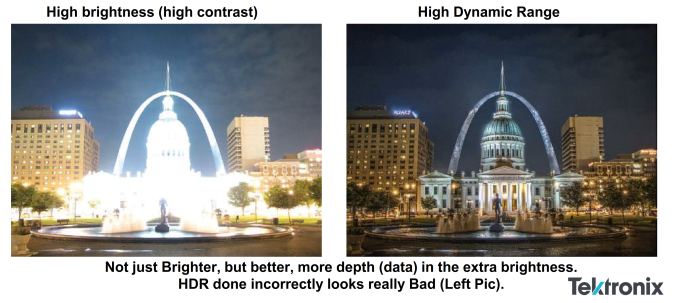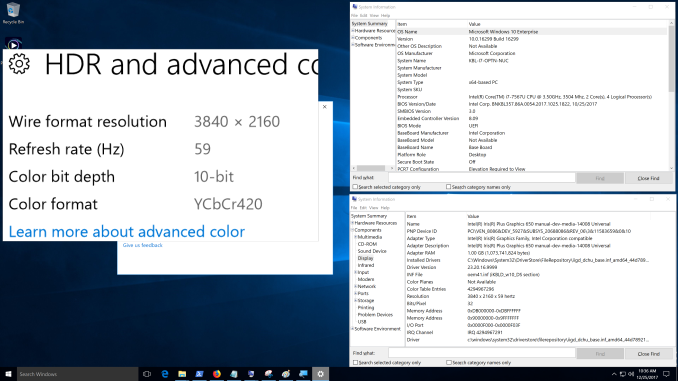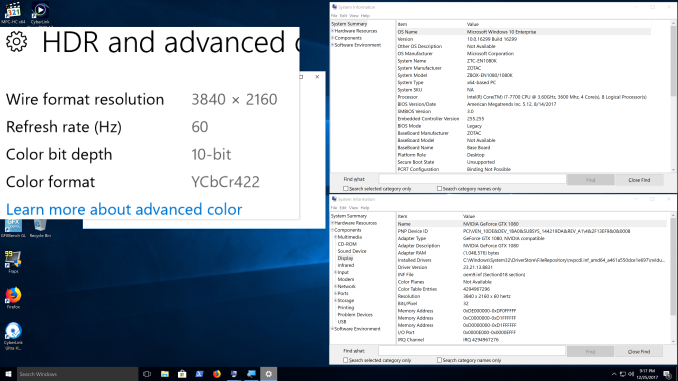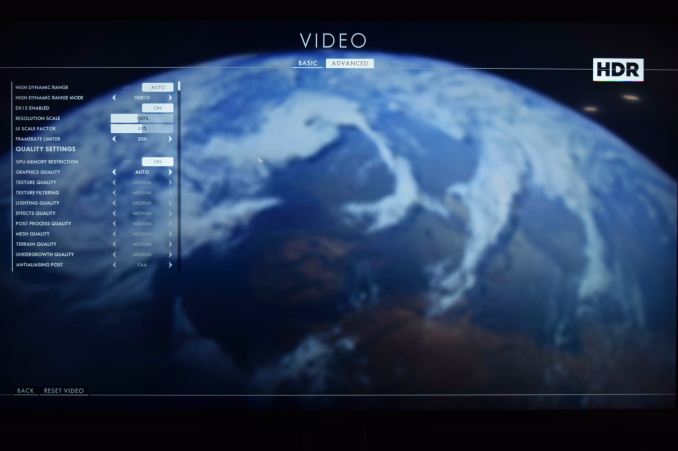A Budget Home Theater & PC Setup: 4K, HDR, UHD Blu-ray, and More
by Ganesh T S on December 26, 2017 8:30 AM ESTHDR Support
High Dynamic Range (HDR) is one of the most impressive features in the recent crop of 4K televisions. In layman's terms, it refers to the ability of a single frame to have wide variation in brightness for different regions. This allows the details in the dimly lit areas of the frame to be seen more clearly. Overall, it delivers a more vivid picture to the viewer. Note that this is quite different from the concept of high contrast.
Picture courtesy: SMPTE HDR Presentation from Steven Holmes of Tektronix
The ability of a display source to transmit HDR frames, as well as that of a display sink to be able to accept and understand them, can be gathered from the HDMI port's specifications. However, being able to accept and understand is only part of the problem. There are many low-cost 'fake HDR' TVs that simply parse the HDR information, but, do not have the ability to translate that to the display.
There are many HDR 'standards', with the base requirement being HDR10. Shifting a display sink into HDR mode involves the source sending some information (metadata) with the characteristics of the video being transported (the mapping of the pixel data to the displayed luminance, light levels in the video stream etc.). If this is static (i.e, done once when the shift to HDR mode occurs), it falls under the HDR10 category. Dolby Vision allows for the metadata to change on a frame-by-frame basis (dynamic). The upcoming HDR10+ standard will also support dynamic metadata. The takeaway is that Dolby Vision certification all but ensures a display with true HDR capabilities.
The TCL 55P607 comes with standard HDR10 and Dolby Vision support. The native Roku apps shift to the appropriate HDR mode based on the content being played back. We will analyze this more in the subsequent sections.
The NVIDIA SHIELD Android TV (SATV) is similar to the native Roku app in the TV with respect to treatment of HDR content. The main issue is that SATV doesn't support Dolby Vision yet, though there is a lot of clamor for it from SATV owners. Videos with HDR10 metadata shift the display to the appropriate HDR mode prior to playback.
PCs encounter additional challenges for HDR implementation. It is just not one company that is responsible for the feature. On one hand, the GPU driver vendors need to support it. On the other hand, the OS itself needs to provide hooks to enable HDR. Finally, the software ecosystem needs to catch up. The Windows 10 Fall Creators Update brought HDR10 capabilities for the Windows desktop into the stable ring. It also allowed streaming of HDR videos from YouTube and Netflix. Microsoft is continuing to fine-tune the HDR capabilities built into Windows 10.
Intel, along with CyberLink, had decided not to wait for Microsoft to deliver HDR on PCs. PowerDVD 17 was the first software Blu-ray player, and it only made sense for them to support HDR playback for applicable titles. The Intel / CyberLink solution for HDR when playing back certain Blu-rays in full-screen exclusive mode is orthogonal to Microsoft's HDR support.
The Windows 10 Fall Creators Update enabled desktop HDR and HDR video streaming on all the three test PCs described earlier.
HDR and Advanced Color Settings - Intel NUC7i7BNHX1 with Desktop HDR Enabled
The KBL-U platforms drove the display at YCbCr 4:2:0 10-bit, while the NVIDIA GTX 1080 drove the HDR output with higher quality (YCbCr 4:2:2 10-bit). For a good desktop experience, 4:4:4 is preferable.
HDR and Advanced Color Settings - Zotac ZBOX MAGNUS EN1080K with Desktop HDR Enabled
Gaming is not a focus in our HTPC reviews, but, we must give credit to NVIDIA for supporting Dolby Vision in their Pascal GPUs. Certain gaming titles such as Battlefield 1 support both HDR varieties (HDR10 and Dolby Vision), and the Zotac EN1080K is able to deliver it in a HTPC environment, thanks to its small form factor and relatively silent liquid cooling.
Battlefield 1 HDR Output from the Zotac EN1080K
Battlefield 1 Dolby Vision Output from the Zotac EN1080K
Unfortunately, Pascal's Dolby Vision support is available only in certain games, and is not applicable to streaming services like Netflix.
Microsoft's current approach to HDR with a desktop HDR mode is currently not efficiently implemented. For example, the desktop in the Zotac ZBOX MAGNUS EN1080K idles at 34.5W. With the HDR mode enabled, this jumps to 39.5W. In the KBL-U systems the penalty is of the order of 0.8W - 1W.















191 Comments
View All Comments
Azethoth - Monday, January 1, 2018 - link
Why don't you go read an article on _not_ home theater, and regale everyone with how awesome the sound from your shitty TV speakers are. Home theater is simply not for your budget, but don't pretend everyone is living in mom's basement.This article may be out of touch with the 5 of you, but it is not out of touch with the rest of the readers.
Why not go whine in articles about supercars about how they are out of touch with 99.999999% of the planet. Oh noes! I still want to read about them though.
Sivar - Wednesday, January 3, 2018 - link
Most Anandtech readers are tech-savvy, but not tech experts and have normal homes, eyes, ears, and middle-level income (of those in the United States).Talk of an OLED TV or projector tells me that it is you who is out of touch with readers, and it doesn't help that your statement to the author was inappropriately rude.
OLED TVs have an objectively better picture quality, but are much more expensive and the difference is not that noticeable to most people.
Projectors are great (I use one) but are impractical for many (most?) homes because they need light control and, for good pricing, a large flat wall for the screen.
Regarding speakers, if the implication is that there is no noticeable difference between them, then yI suspect you are not at all an enthusiast of home theater. This isn't even a reasonable debate, it just leaves me dumbfounded. True that there is little difference between an extremely fancy speakers (say from Focal or Magico) and a good set of well-designed towers such as those from Ascend or JBL, and indeed the audio industry has a lot of snake oil like expensive cables and any Bose product, but to say that a speaker "works or it doesn't" proves little experience with sound systems, even in the sub-$500 range.
SunnyHours - Wednesday, July 11, 2018 - link
Totally agree with you there!Especially your comment about Cables, Bose (I HATE BOSE!) and mostly the comment that "either a speaker works or it doesn't" that just really surprised me and made me wonder how this person can even entertain the idea of giving tips on a subject you know nothing about...especially on the internet where people will put you on the spot and call you for being an ignorant person and at the same time being a "know it all".
Next thing he will say is that "Vinyls sound like crap and cassettes were a much improved product" LOL.
Dug - Friday, January 5, 2018 - link
He's not out of touch. A good balanced receiver will last much longer in a system than video. Most people upgrade video (tv's, monitors, etc), than they do sound. Projectors don't really fall into the family room scenario either. Usually too much light, sound, maintenance, setup, etc. Plus there's no real 4k hdr affordable projectors out.Bullwinkle-J-Moose - Thursday, December 28, 2017 - link
"So you want a home theater system but don't want to get an AV receiver?"-----------------------------------------------------------------------------------------------------
Why not?
I have a 35 Watt dual-core Sandy Bridge with optical audio output to my Digital EQ (Behringer DEQ24/96) and Balanced XLR to each JBL LSR305 powered monitor
(Behinger AD converters sound like crap but with an optical input, it sounds Fantastical)
Much better than a Denon receiver I do believe
Sure, it's completely Gimped when its running Windows 10 DRM garbage
But, if I want to run 4K on a Gimped System, I can boot to 7 / 8.1 or Spyware Platform 10
I'm running Windows XP right now so I don't need to worry about Bluescreens of Death, malware, or Viruses like I do with Spyware 10
Burns BlueRay Disks fine and can boot to a stock install of XP in 3-4 seconds from a Samsung 850 Pro
Any computer newer than Sandy Bridge is nothing more than a Locked Down Gaming Console with a web browser attached and they make for really piss poor home theater setups
"Personal" Computers died with Sandy Bridge!
You are just renting a JukeBox
Azethoth - Monday, January 1, 2018 - link
I am missing the part where your "fantastical" Behringer DEQ24/96 decodes Dolby Surround.You are failing at Home Theater. There are standards. One of them is surround sound.
Stereo is for listening to old timey music. I am willing to put my Denon in surround stereo up against your stereo thing anytime. I will also pretend that Denon is better, except it would actually be true unlike your imaginings where an optical in somehow makes a difference.
Just so you know, hard science and engineering tells us that an optical in connection means you 100% do not have what this article is about: the more part of 4k blu ray. Atmos does not fit into optical. Hell, 7.1 and 9.1 surround did not fit.
So you and the rest here are just bloviating without saying anything relevant to the topic.
tl;dr If it is beyond your budget, quit whining and read the follow up article next year. Everything will be cheaper and better.
Bullwinkle-J-Moose - Monday, January 1, 2018 - link
"I am missing the part where your "fantastical" Behringer DEQ24/96 decodes Dolby Surround.You are failing at Home Theater. There are standards. One of them is surround sound."
--------------------------------------------------------------------------------------------------------------------
There is no "Standard" to Home Theater!
Surround Sound is one of many so called "Standards"
Your "Budget" demands "Your Standards"
3.1 / 5.1 / 7.1 / 9.1 are simply additions to the 3.0 "Standard" that I created over 30 years ago
They do not Image a "Standard" stereo output as well as mine and yet you claim "They" are the "Standard"
Advertising propaganda has taught you well
Now go forth and spew nonsense
A "Budget" Home Theater can be whatever you want it to be
Racing Stripes and RGB lighting may cost extra
Reflex - Monday, January 1, 2018 - link
I am unclear on how your setup will do positional audio in a home theater setup. For instance, if I play back DD5.1 content, will your setup put the appropriate audio and effects behind a viewer? If I play Dolby Atmos or DTS X content, will it additionally place the appropriate audio above the viewer's head? If so, how are you handling the decode operation for those standards to translate them to your proprietary speaker number and arrangement?Thanks!
Bullwinkle-J-Moose - Tuesday, January 2, 2018 - link
"If I play Dolby Atmos or DTS X content, will it additionally place the appropriate audio above the viewer's head? If so, how are you handling the decode operation for those standards to translate them to your proprietary speaker number and arrangement?"-------------------------------------------------------------------------------
I support my original "Reference Standard" which preceded Atmos and DTS X
I do not support other "Non-Standards" which came later
The only way a "Non-Standard" Home Theater experience can match the "Stereo" Imaging accuracy of my Reference "Standard" is to steal my design
If Dolby or anyone else can claim to match the Imaging accuracy of my Reference Design, then there are really only two possibilities here that I can see
A: They stole my design
or
B: They are Liars
There either ONE Reference, or there is no reference
Choose Now!
Bullwinkle-J-Moose - Tuesday, January 2, 2018 - link
There is either ONE Reference, or there is no reference at all